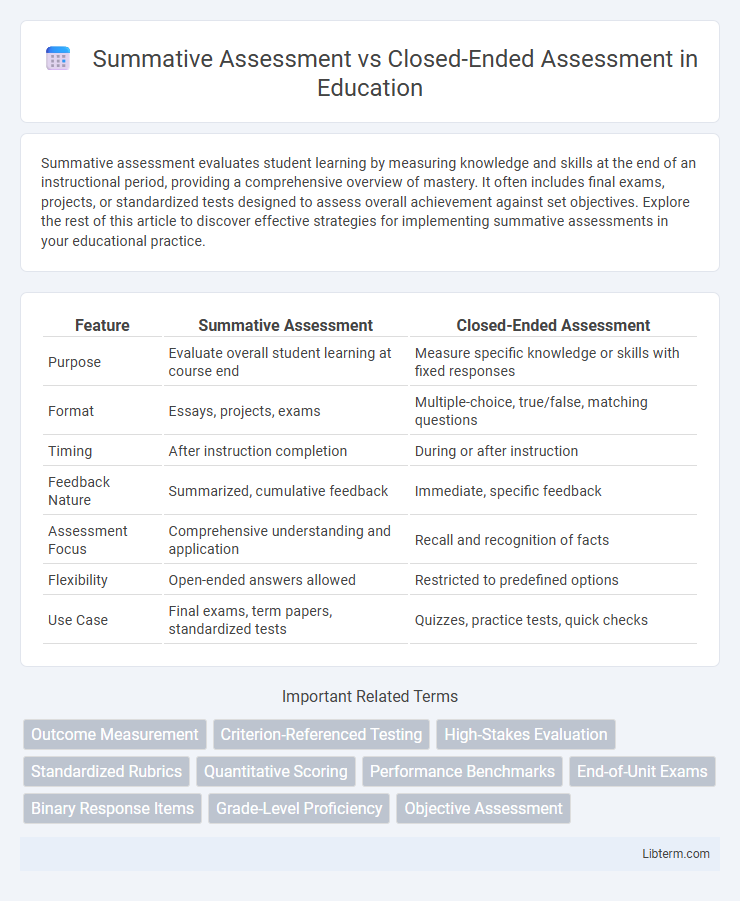Summative assessment evaluates student learning by measuring knowledge and skills at the end of an instructional period, providing a comprehensive overview of mastery. It often includes final exams, projects, or standardized tests designed to assess overall achievement against set objectives. Explore the rest of this article to discover effective strategies for implementing summative assessments in your educational practice.
Table of Comparison
| Feature | Summative Assessment | Closed-Ended Assessment |
|---|---|---|
| Purpose | Evaluate overall student learning at course end | Measure specific knowledge or skills with fixed responses |
| Format | Essays, projects, exams | Multiple-choice, true/false, matching questions |
| Timing | After instruction completion | During or after instruction |
| Feedback Nature | Summarized, cumulative feedback | Immediate, specific feedback |
| Assessment Focus | Comprehensive understanding and application | Recall and recognition of facts |
| Flexibility | Open-ended answers allowed | Restricted to predefined options |
| Use Case | Final exams, term papers, standardized tests | Quizzes, practice tests, quick checks |
Introduction to Summative and Closed-Ended Assessments
Summative assessments evaluate student learning at the end of an instructional period by measuring mastery of specific learning objectives, often using standardized tests or final projects. Closed-ended assessments consist of fixed-response questions such as multiple-choice, true/false, or matching items, enabling quick scoring and objective measurement of knowledge. Both assessment types serve to quantify student performance, with summative assessments providing a comprehensive overview and closed-ended assessments offering precise data on specific content areas.
Defining Summative Assessment
Summative assessment evaluates student learning at the end of an instructional period by measuring mastery of specific skills or knowledge through final exams, projects, or standardized tests. Unlike closed-ended assessments, which use fixed-response formats such as multiple-choice or true/false questions, summative assessments may include diverse formats that provide comprehensive insights into overall achievement. These evaluations are critical for validating educational outcomes and guiding future instruction.
Understanding Closed-Ended Assessment
Closed-ended assessment uses fixed-response questions such as multiple-choice, true/false, and matching items to measure specific knowledge or skills efficiently and objectively. This method facilitates quick scoring and easy comparison across different test-takers but may limit deeper understanding and critical thinking evaluation. Summative assessment often incorporates closed-ended items to provide a comprehensive evaluation of student learning outcomes at the end of an instructional period.
Key Differences Between Summative and Closed-Ended Assessments
Summative assessment evaluates overall student learning at the end of an instructional period, emphasizing comprehensive understanding and mastery of content. Closed-ended assessments consist of fixed-response questions like multiple-choice or true/false, primarily measuring specific knowledge or skills with quantifiable results. Key differences include summative assessments' broader scope and purpose for final evaluation versus closed-ended assessments' focus on objective, easily scored items often used within formative or summative contexts.
Purposes and Objectives of Each Assessment Type
Summative assessment aims to evaluate overall student learning and mastery of content at the end of an instructional period, providing a comprehensive measure of achievement aligned with curriculum standards. Closed-ended assessment focuses on specific, objective questions with predetermined answers designed to assess knowledge retention, factual recall, and precise understanding of particular topics. The primary purpose of summative assessment is to inform final grading and curriculum effectiveness, while closed-ended assessment serves to gauge discrete learning outcomes and facilitate efficient, reliable scoring.
Examples of Summative vs Closed-Ended Assessments
Summative assessments, such as final exams, standardized tests, and end-of-term projects, evaluate overall student learning and mastery of content after instruction. Closed-ended assessments include multiple-choice questions, true/false items, and matching exercises that have predetermined correct answers and are typically used to measure specific knowledge or skills. While summative assessments provide a comprehensive evaluation, closed-ended assessments focus on objective measurement of defined learning objectives.
Advantages of Summative Assessment
Summative assessment provides a comprehensive evaluation of student learning by measuring mastery of content at the end of an instructional period, which helps in identifying overall academic progress and achievement. It supports data-driven decision making for educators by offering clear benchmarks and standardized results that can guide curriculum improvements and accountability. Unlike closed-ended assessments, summative assessments often incorporate diverse formats like essays and projects, promoting critical thinking and deeper understanding of the subject matter.
Benefits and Limitations of Closed-Ended Assessment
Closed-ended assessments offer clear advantages such as ease of grading, objective scoring, and efficiency in testing large groups, making them ideal for standardized testing and data-driven evaluations. However, their limitations include restricted ability to measure higher-order thinking skills, creativity, and deep understanding, often resulting in surface-level assessment of knowledge. These assessments may also encourage guessing and provide limited diagnostic feedback for personalized learning interventions.
Best Practices for Using Each Assessment Type
Summative assessment is most effective when used at the end of instructional units to measure student learning outcomes against established standards, employing comprehensive tools like final exams or standardized tests for objective evaluation. Closed-ended assessments work best for quick, factual knowledge checks with multiple-choice or true/false questions, enabling efficient scoring and immediate feedback. Best practices include aligning summative assessments with curriculum goals for validity and designing closed-ended questions that minimize ambiguity to ensure reliability and accuracy in measuring specific skills or knowledge.
Choosing the Right Assessment for Your Learning Goals
Summative assessment evaluates overall student learning at the end of an instructional period, offering comprehensive insights into knowledge retention and skill mastery, while closed-ended assessment uses fixed-response questions like multiple-choice to measure specific learning objectives efficiently. Selecting the right assessment depends on your learning goals: choose summative assessments for evaluating cumulative understanding and long-term outcomes, and closed-ended assessments for quick, objective measurement of discrete skills or concepts. Aligning assessment type with educational objectives ensures accurate data to guide instructional decisions and improve student performance.
Summative Assessment Infographic

 libterm.com
libterm.com